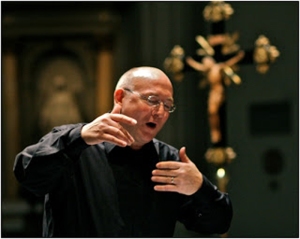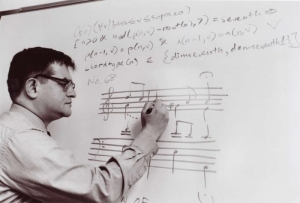Tags
Antonio Veracini, basso continuo, bassoon, Boulder Bach Festival, Buxtehude, Chaconne in D minor, chorale, chorale partita, coloratura, continuo, Dario Castello, Dresden, Duetto no. 3 in G Major, Duo Crezdi, Fifteen Inventions, First Congregational Church, Florence, Georg Böhm, gigue, harpsichord, Heinrich Ignaz Franz Biber, Johann Ludwig Krebs, Josquin des Prez, Leipzig, minuet, organ, partita, passacaglia, Paul Miller, Peter Wollny, Rick Erickson, Rosary Sonatas, Sacred Mysteries, scordatura, Sei gegrüsset Jesu gütig, sonata, Sonata in G minor, Sonata No. 4 in C minor, Sonata Prima in A minor from Libro secundo, tetrachord, Vater unser im Himmelreich, Venice, violin, Zachary Carrettin

Duo Crezdi
In the final concert of the thirty-second season of the Boulder Bach Festival, Zachary Carrettin, violin, and Rick Erickson, harpsichord and organ, will join forces as Duo Crezdi in an artist recital at First Congregational Church in Boulder, Colorado at 7:30 pm on Friday, 3 May 2013.
The violin sonatas on the program will come from very different places and times. The earliest is Dario Castello’s Sonata Prima in A minor from Libro secundo. Diligent scholarship has not been able to determine any exact dates for Castello’s birth or death. In fact, almost no shreds of biographical evidence exist about the composer. This much is known: Castello lived much of his life in and around Venice. He was an excellent wind player and a master of the bassoon, an instrument which was very popular in Venice at the time. He published two books of sonatas in 1621 and 1629, which were so popular that they were reprinted in the 1640s and 50s. His sonatas are made up of a number of short contrasting sections and the work to be performed by the Duo Crezdi is no exception. As one of the first to write idiomatically for the violin, Castello’s music has a refreshing and delightful spontaneity about it which is easy to hear even four hundred years later.
Biber’s (1644-1704) Passacaglia stands as the last piece in the composer’s ambitious cycle of Rosary Sonatas. For each of the fifteen Sacred Mysteries, Biber composed a violin sonata, but each one is in a different tuning, or scordatura. In the sole surviving copy of the score, every sonata is prefaced by a lovely copper engraving. The Passacaglia is the last piece in the cycle, and the only one for violin without continuo. It is the only sonata that “duplicates” an earlier tuning for the violin – in this case, the ordinary tuning G – D – A – E. The Passacaglia consists of sixty-five repetitions of a descending tetrachord (four-note motive) in which all manner of harmony, melody and expression appears. In the middle of the piece, the descending motive even appears in an upper voice, complicating matters for the interpreter. Claiming the prize as probably the most elaborate composition for solo violin up to that time, Biber’s Passacaglia almost surely had some influence on J. S. Bach when he composed, some decades later, his own magnificent Chaconne in D minor (BWV 1004) for solo violin.
Chronologically speaking, the Bach and Veracini sonatas date from almost the same time. Bach’s six accompanied sonatas for violin and keyboard were composed no later than 1725, and the composer continued to tinker with them for many years thereafter. The Sonata No. 4 in C minor (BWV 1017) is cast very much in the mold of a trio sonata. As Peter Wollny noted, each part (violin, keyboard right hand, keyboard left hand) has its own rhythmic character in the slow movements. For example, in the third movement the violin has a lyrical melody, the right hand of the keyboard has continuous triplets, and the left hand has a bass line mostly in quarter notes. The two fast movements feature dense counterpoint and imitative textures, perfectly in keeping with the idea that each part should be interesting and meaningful in and of itself.
Antonio Veracini (1659-1733) led a colorful life and held important posts in Florence and Dresden. As the story goes, he once claimed that “as there is one God, there is one Veracini.” Without lacking a sense of drama either in life or in music, Veracini once jumped out of a building during an argument in Dresden. He even survived a shipwreck in the English Channel. Veracini’s nephew diplomatically wrote that “the heart, rather than cleverness, guided [Veracini’s] finger and bow.” Of his many published violin works, Veracini’s Sonata in G minor (appearing in 1721 as op. 1, no. 1) is an intense, many-colored piece. Opening with a broad French-style introduction, it quickly moves through an impetuous Allegro before settling into a more lyrical Aria. The anxious Allegro that follows contains several outbursts that might have given even the stoic Bach a severe case of indigestion. The final two movements, a short Minuet and an almost ridiculous Gigue that alludes to the sound of the postman’s bell, do little to dispel the image of an undeniably brilliant, yet slightly unstable, musical mind.
Two works for organ on the concert will feature compositions by men who were close to the Bach circle personally. Johann Ludwig Krebs (1713-1780) studied with Bach in Leipzig. The use of the letters of Bach’s name in the fugue subject reflect an ancient practice, dating back to Josquin, called soggetto cavato (“carved subject”) where the letters of a name determine the musical notes. We therefore have, according to German spelling, a subject of B-flat, A, C, B-natural.
Georg Böhm (1661-1733) was connected to the Bach family from his studies in Ohrdruf, a town which knew several generations of Bachs. Böhm might have tutored the young J. S. Bach but there is no direct evidence to support this assertion. Much later, C. P. E. Bach claimed that his father, J. S., loved to study Böhm’s music. Böhm’s Vater unser im Himmelreich is stylistically much like Buxtehude’s music. It is probably one of the most expressive works he penned. Particularly noteworthy is Böhm’s exploration of the organ’s high coloratura register.
The remaining works by J. S. Bach will show his mastery both of small-scale and large-scale musical forms. The Duetto no. 3 in G Major (BWV 804) is similar in texture to one of Bach’s famous Fifteen Inventions (BWV 772-86), but it is more extended and elaborate. Bach derives an entire motivic menagerie by exploring the possibilities of a simple seven-note cell, heard at the beginning in the right hand. Contrasting with this small scale form, the chorale partita for organ on Sei gegrüsset, Jesu gütig (BWV 768) is an extended set of variations on a chorale tune. This is the most ornate of the four sets of chorale variations Bach left us and contains eleven variations on the tune. The variations range from simple to elaborate and give us a full spectrum of Bach’s powers of inventiveness.
Paul Miller – Boulder Bach Festival


 Last year, the Oregon Bach Festival launched a digital project that took listeners through J. S. Bach’s Mass in B minor (BWV 232) and the Goldberg Variations (BWV 988) with video, graphics, and line-by-line following of the music. This year, the festival takes listeners similarly through Bach’s St. Matthew Passion (BWV 244), which it will perform this summer.
Last year, the Oregon Bach Festival launched a digital project that took listeners through J. S. Bach’s Mass in B minor (BWV 232) and the Goldberg Variations (BWV 988) with video, graphics, and line-by-line following of the music. This year, the festival takes listeners similarly through Bach’s St. Matthew Passion (BWV 244), which it will perform this summer. Every so often a performance comes along that is so novel, so radical, that it triggers an entire paradigm shift in the way we understand the great cornerstones of classical music. Sometimes that novelty comes down to emotional daring or sheer virtuosity; sometimes it’s an academic argument that’s too persuasive to be ignored. The new recording of Bach’s St. John Passion (BWV 245) from Professor John Butt and his Edinburgh-based Dunedin Consort might just be one of the latter.
Every so often a performance comes along that is so novel, so radical, that it triggers an entire paradigm shift in the way we understand the great cornerstones of classical music. Sometimes that novelty comes down to emotional daring or sheer virtuosity; sometimes it’s an academic argument that’s too persuasive to be ignored. The new recording of Bach’s St. John Passion (BWV 245) from Professor John Butt and his Edinburgh-based Dunedin Consort might just be one of the latter.
 The Orgelbüchlein Project is a project to complete Bach’s unfinished collection of organ miniatures. His manuscript contains titles for one hundred sixty-four chorales, but he only completed forty-six of them (BWV 599-644). One by one, the English organist William Whitehead is commissioning composers from round the world to fill in the blanks, using the melody Bach intended, but never got around to completing.
The Orgelbüchlein Project is a project to complete Bach’s unfinished collection of organ miniatures. His manuscript contains titles for one hundred sixty-four chorales, but he only completed forty-six of them (BWV 599-644). One by one, the English organist William Whitehead is commissioning composers from round the world to fill in the blanks, using the melody Bach intended, but never got around to completing. Edward McCue (EM) Zachary, how are Rick Erickson and you interpreting this year’s Boulder Bach Festival theme, “Bach, the Passionate?”
Edward McCue (EM) Zachary, how are Rick Erickson and you interpreting this year’s Boulder Bach Festival theme, “Bach, the Passionate?”
 The year 2012 is unlikely to go down well in the annals of Jewish-German relations.
The year 2012 is unlikely to go down well in the annals of Jewish-German relations.


 After emigrating to the United States, Ebcioğlu wrote a doctoral dissertation at the State University of New York/Buffalo (“An Expert System for Harmonization of Chorales in the Style of J. S. Bach”) that proposed an approach to creating a simple form of tonal music with a computer algorithm, based on simultaneous adherence to three principles:
After emigrating to the United States, Ebcioğlu wrote a doctoral dissertation at the State University of New York/Buffalo (“An Expert System for Harmonization of Chorales in the Style of J. S. Bach”) that proposed an approach to creating a simple form of tonal music with a computer algorithm, based on simultaneous adherence to three principles: